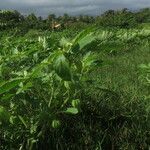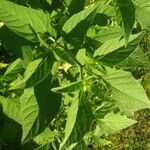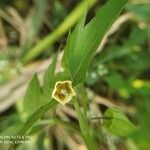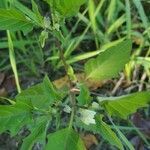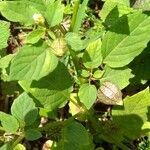Calyx (2.5)3–5(7) mm long, (2)2.5–3.5(4) mm across at the base of the lobes, campanulate, sub-angled or ribbed, truncate or invaginated at the base, puberulous sometimes only along the nerves or subglabrous, usually with ± sessile glands more abundant towards the base, on the inside glabrous except for the lobes with ± dense, minute indumentum on the upper half or only near the apex and the margins; lobes unequal or subequal, (1.2)1.5–3(3.5) × 1–2 mm, ovate-triangular or deltoid to triangular-lanceolate, acute or acuminate, occasionally sub-acute or obtuse, ciliate; in fruit green to greenish-yellow, often darker veined, sometimes purple towards the base or also with purplish venation, 20–30(35) × 15–25(30) mm, ovoid or subglobose slightly 10-angled or 10-ribbed, sometimes ± terete, shortly acuminate or slightly apiculate at the summit, half to three-quarters filled by the fruit, ± glabrous, often scabrid near or at the margins and apex of the lobes, the lobes 3–7(8) × 2–4(5) mm.
Corolla yellow or greenish-yellow to whitish, usually unmarked, sometimes red-brown to greyish-brown or mauve at the mouth or also so towards the base, more rarely blotched with 5 fuscous or purplish markings slightly or not contrasting with the surrounding limb, (4)5–9(10) mm long, infundibular-rotate or tubular-campanulate; tube ± glabrous, with a few, sessile glands, on the inside somewhat hairy with minute hyaline hairs, also with ± sessile glands, with a ring of hyaline hairs at the mouth; limb (4)6–11(12) mm across, shortly 5-lobed, erect or spreading, occasionally reflexed when fully expanded, with dense, ± appressed, short hairs and also sessile glands on the parts not folded in bud, glabrous inside, ciliate.
Annual, 2–10 dm, glabrous, or with a few short appressed hairs especially on the younger parts; lvs mostly 4–10 cm, ovate to lance-ovate, irregularly and often coarsely toothed to entire; cor yellowish, not dark in the center, 4–10 mm; anthers 1–2.3 mm; 2n=24, 48. Tropical Amer., n. to se. Va. and Mo., and rarely adventive northward. Summer. Var. angulata, with essentially the range of the sp., has pedicels 5–15 mm in fl, 20–30 mm in fr, the cal-teeth 2–2.5 mm in fl, the mature cal 2.5–3.5 cm. The well marked var. pendula (Rydb.) Waterf., of Mo. to Kans. and Tex., and occasionally intr. eastward, has pedicels 15–40 mm in fl, 20–40 mm in fr, the cal-teeth 1 mm in fl, the mature cal 2–2.5 cm. (P. pendula)
Small herb to 50 cm high, bushy or erect, almost glabrous. Leaves ovate, sometimes asymmetric at base, entire or irregularly toothed, acute to acuminate; lamina to 9 cm long and 5 cm wide; petiole to 4–6 cm long. Pedicels slender, 8–12 mm long. Calyx 4 mm long, sparsely and shortly appressed-pubescent externally. Corolla 6–7 mm long, sparsely and shortly pubescent externally, cream, brown at base of petals. Filaments c. 3 mm long; anthers 1.5–2.5 mm long. Berry c. 8 mm long on short, thickened, annular disc, glabrous; inflated fruiting calyx 7–25 mm long, glabrous, pale green with 5 fine, purplish ridges; pedicel apparently not lengthening in fruit. Seeds c. 1.5 mm long, minutely pitted, brownish.
Erect, annual herb, up to 0.9 m high. Stems strongly angled and grooved, green. Leaves ovate to elliptical, up to 100 x 60 mm, margins dentate, base unequal, often decurrent on petiole; petioles up to 50 mm long. Flowers solitary, axillary; pedicels slender, up to 10 mm long. Calyx 5 mm long, shortly lobed above. Corolla spreading, ± 6 mm long, ± 10 mm in diam., yellow, centres often mauve. Flowering time Dec.-May. Fruit globose berries, ± 10-15 mm in diam., glabrous, ± yellow, inside ovoid, inflated calyces 30 mm long. Seeds many, lenticular, 2.5 mm in diam., glabrous, very finely pitted, golden-brown.
Leaves usually solitary; petiole (0.5)1–5(7) cm long; lamina (1.5)2–8(10) × (0.5)1.5–4.5(6) cm, ovate to lanceolate, sometimes elliptic or ± oblong, rarely subrotund, obovate or oblanceolate, base cuneate or attenuate, sometimes obtuse, rounded, truncate or subcordate, and often oblique or unequal-sided, ± decurrent into the petiole, apex acute or acutely acuminate, sometimes sub-acute or obtuse, deeply or coarsely dentate to entire, the teeth unequal, very acute to rather obtuse, the sinuses rounded, ± glabrous or sparsely puberulous on the nerves and sometimes also near the margins mainly beneath.
Annual herb, up to 0.5 m high; glabrescent, hairs minute. Leaves petiolate; blade ovate, 40-60 x 20-30 mm, apex acute, base rounded to cuneate, margins entire or shallowly toothed; petioles up to 60 mm long. Flowers: solitary, axillary; anthers pale blue, ± 2 mm long; calyx accrescent, 10-angled, 5 major and 5 minor veins; corolla 5-8 mm long, pale yellow with brown markings at base; Jan.-Dec. Fruit a globose berry, 8-14 mm in diameter, enclosed by a bladder-like calyx.
A perennial herb up to about 1 m high. The leaves are smooth. The stems are angular. The leaves are oval and have teeth along the edge. They are 5-10 cm long by 3-6 cm wide. The flowers occur singly. The flowers are small and cream coloured. They do not have a dark spot. It has a yellow berry with many seeds inside. The berry is enclosed in a veiny inflated case about 3 cm across. This has reddish brown veins. The berries are sticky.
Glabrous or sparsely hairy annual herb, 0.25-1.00 m high. Leaves ovate to ovate-lanceolate, deeply and irregularly incised-toothed to undulate-toothed, sometimes entire, 50-110 x 35-80 mm, petiolate. Corolla lobes spreading to 10 mm diam. Anthers 1.0-2.5 mm long, bluish or violet. Fruiting calyx 10-angled or 10-ribbed and nearly terete. Flowers yellowish, sometimes with indistinct spots.
Erect to procumbent or prostrate, weak to ± robust, often diffusely much branched, sometimes dichotomously so, annual (or rarely ?short-lived perennial) herb, sometimes ± tinged purple, glabrous or sparsely clothed with simple, ± appressed, short and minute, usually eglandular hairs, more abundant especially on new growth, furnished also with ± sessile glands.
Stamens included or exserted, subequal or unequal, glabrous; filaments (1.5)2–4(5) mm long, filiform, attached to the corolla tube near the base; anthers bluish or violaceous, sometimes fading yellowish, 1.5–2.5 mm long, oblong or narrowly ovate-oblong in outline, straight after anthesis.
Flowers solitary, axillary, erect to nodding; pedicel greenish, violaceous or purplish, (5)6–12(16) mm long, glabrous or rarely with scattered, minute hairs, usually with ± sessile glands, in fruit elongating to 22(25) mm.
Seeds yellowish to pale brown or rufescent, 1.3–1.8 × 1–1.5 mm, ovate, elliptic or ± orbicular in outline, sometimes reniform, reticulate-foveate.
Fruit green to yellow, sessile on the invaginated base of the pendulous calyx, (10)11–15(16) mm in diameter, ± globose, viscid.
Ovary 1.2–2 × 1–1.8 mm, subglobose or ± ovoid, glabrous; style (3)3.5–5(6) mm long, filiform, straight or curved upwards.
Branches angular or angular-ribbed, striate, drying ± sulcate, glabrous or puberulous.
Disk 0.2–0.3 mm high, fleshy, glabrous.
Erect glabrous annual up to 3 ft. high
Flowers cream.
